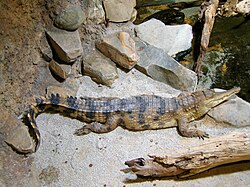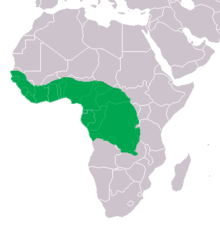West African slender-snouted crocodile
| Slender-snouted crocodile Temporal range: Paleocene – Recent
| |
|---|---|

| |
| Scientific classification | |
| Kingdom: | |
| Phylum: | |
| Class: | |
| Order: | |
| Family: | |
| Subfamily: | |
| Genus: | Mecistops Gray, 1844
|
| Species: | M. cataphractus
|
| Binomial name | |
| Mecistops cataphractus (Cuvier, 1825)
| |

| |
| Range map | |
| Synonyms | |
|
Crocodylus cataphractus Cuvier, 1825 | |
The slender-snouted crocodile (Mecistops cataphractus) is a critically endangered species of crocodile from Africa. Traditionally placed in Crocodylus, recent studies in DNA and morphology suggest that it belongs in its own genus, Mecistops.[2][3][4][5]
Description
Slender-snouted crocodiles are native to freshwater habitats in central and western Africa. They are medium-sized crocodiles, typically slightly smaller than the Nile crocodile, but are larger than several other species of crocodilians. Adults are typically about 2.5 m (8.2 ft) long, but have been known to reach 4.2 m (14 ft).[6][7] They weigh between 125 and 325 kg (276 and 717 lb).[8][9] They have a slender snout used for catching prey, hence their name.
Behaviour

The diet of the slender-snouted crocodile consists mainly of fish, amphibians and crustaceans. Adults occasionally take smaller mammals, aquatic snakes, turtles and birds.[1] This species is not typically found in groups, except during the onset of the breeding season. The female constructs a mound nest consisting mainly of plant matter. Nests are sited on the banks of rivers, and construction generally begins at the onset of the wet season, although breeding is asynchronous even within members of one population. It has a similar, but generally shorter nesting season than that of the sympatric dwarf crocodile, which may nest further from the riverine habitat frequented by C. cataphractus.
The slender-snouted crocodile lays an average of 16 (minimum 13, maximum 27) very large eggs (relative to body size) about a week after completion of the mound nest. The incubation period is long compared with most other crocodilian species, sometimes lasting over 110 days. The female remains close to the nest, but does not defend it with the same vigor as some other species of crocodilians. Once the eggs begin to hatch, and the juveniles emit their characteristic chirping, she will break open the nest and assist in the hatching process. Hatchlings then disperse across the flooded forest floor. Although losses from predators do occur (e.g. by soft-shelled turtles), they apparently are minimal, possibly accounting for the small number of relatively large eggs laid, and the long incubation period. They also have very sharp teeth for protection. It is one of four species of crocodile in Africa, the other three being the Nile, desert and dwarf crocodiles.
Status
This species is relatively poorly known with few studies of the wild populations. Consequently, it was rated as Data Deficient by the IUCN in 1996. Following a review in 2014, it was moved to Critically Endangered.[1] It appears to have been entirely extirpated from several countries where formerly present and declined elsewhere.[1] Threats include hunting (skin and bushmeat), habitat loss, overfishing (it mainly feeds on fish) and general disturbance (it is very shy). There is considerable uncertainty about the size of the wild population, but it is estimated that between 1,000 and 20,000 remain.[1] Slender-snouted crocodiles are kept and bred at a number of zoos in Europe and North America, and the Ivory Coast is considering starting a captive breeding program.[1] Among North American zoos, Busch Gardens in Florida has a captive breeding program hoping to reintroduce animals back into the wild.[citation needed]
Taxonomy
Recent genetic and morphological evidence suggests that the slender-snouted crocodile in fact comprises two separate species composed of a central African population (Mecistops cataphractus) and the as yet unnamed west African population. The western species would, in fact, class as one of the most endangered species of crocodilian, and scientists have estimated that the two populations have been separate for 6.5-7.5 million years.
References
- ^ a b c d e f Template:IUCN2015.1
- ^ McAliley, Willis, Ray, White, Brochu & Densmore (2006). Are crocodiles really monophyletic?—Evidence for subdivisions from sequence and morphological data. Molecular Phylogenetics and Evolution 39: 16–32.
- ^ Brochu, C. A.; Njau, J.; Blumenschine, R. J.; Densmore, L. D. (2010). "A New Horned Crocodile from the Plio-Pleistocene Hominid Sites at Olduvai Gorge, Tanzania". PLoS ONE. 5 (2): e9333. doi:10.1371/journal.pone.0009333. PMC 2827537. PMID 20195356.
{{cite journal}}: CS1 maint: unflagged free DOI (link) - ^ Robert W. Meredith; Evon R. Hekkala; George Amato; John Gatesy (2011). "A phylogenetic hypothesis for Crocodylus (Crocodylia) based on mitochondrial DNA: Evidence for a trans-Atlantic voyage from Africa to the New World". Molecular Phylogenetics and Evolution. 60: 183–191. doi:10.1016/j.ympev.2011.03.026.
{{cite journal}}: Unknown parameter|last-author-amp=ignored (|name-list-style=suggested) (help) - ^ Brochu, C. A.; Storrs, G. W. (2012). "A giant crocodile from the Plio-Pleistocene of Kenya, the phylogenetic relationships of Neogene African crocodylines, and the antiquity of Crocodylus in Africa". Journal of Vertebrate Paleontology. 32 (3): 587. doi:10.1080/02724634.2012.652324.
- ^ WAZA: Crocodylus cataphractus. Retrieved 18 January 2016.
- ^ Crocodilians, Natural History & Conservation: Crocodylus/Mecistops cataphractus. Retrieved 18 January 2016.
- ^ African Slender-Snouted Crocodile | The Maryland Zoo in Baltimore. Marylandzoo.org. Retrieved on 2014-05-07.
- ^ Slender-Snouted Crocodile | San Diego Zoo Animals. Sandiegozoo.org. Retrieved on 2014-05-07.

